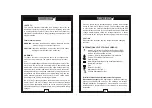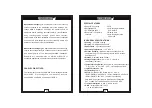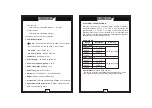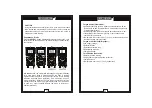
20
®
For gas flames (Flame Rod):
Ignition interference (A flame signal current difference with the
ignition both on and off greater than 0.5A indicates the presence
of ignition interference)
Insufficient ground (must be at least 4 times the detector area)
Flame lifting off burner head (ground), or not continuously in
contact with the flame rod
Temperature in excess of 600 oF (316 oC) at the flame electrode
insulator causing short to ground.
For gas or oil flames (Minipeeper) :
Low supply voltage
Detector location
Defective detector wiring
Dirty viewing windows
Faulty Minipeeper
For oil flames (Photocell) :
Detector location & wiring
Smoky flame or poorly adjusted air shutter
Faulty Photocell
Temperature over 165 oF (74 oC) at photocell
®
19
CAUTION
Using resistance and continuity function in a live circuit will produce
false results and may damage the instrument. In many cases the
suspected component must be disconnected from the circuit to
obtain an accurate reading
Capacitance; Diode
Press the
SELECT
button momentarily to toggle the functions. Last
selection will be saved as power up default for repeat measurement
convenience.
In
Diode
function, the normal forward voltage drop (forward biased)
for a good silicon diode is between 0.400V to 0.900V. A reading
higher than that indicates a leaky diode (defective). A zero reading
indicates a shorted diode (defective). An OL indicates an open
diode (defective). Reverse the test leads connections (reverse
biased) across the diode. The digital display shows OL if the diode
is good. Any other readings indicate the diode is resistive or
shorted (defective).


































